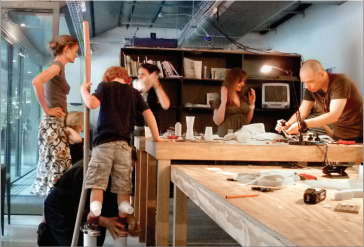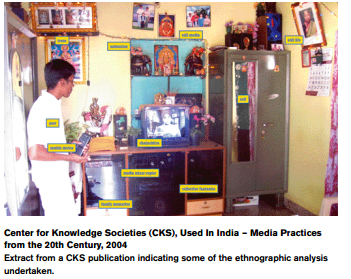Web Design
Portfolio
ABOUT
CONTACT
Teodora Muresan
Digital Media Events
Mobile App
Reading reflections
Hotglue
Reading
Processing
Home
1. Circles and Props— Making Unknown Technology
Authors: Kristina Andersen, STEIM and Danielle Wilde, RMIT University
Volume 19, Number 3 (2012), Pages 60-65
This paper is about the OWL Project which was based on creating an environment that allows people to design different artifacts, depending on their own needs. There wasn’t a specifically targeted age group, the project involving both children and adults. All participants are given 15 minutes to identify a desire, the body part in which their chosen desire resides, to choose the material they are going to work with and then to build it. Because of the short period of time given, the participants do not have time to think their projects through and are forced to “think with their hands”. At the end of the session, all participants are individually filmed while explaining the purpose of their artifacts.
I found this article particularly interesting, since it can be applied to a wide range of people, especially to students, in order to enhance the creative process.

The process of creating described in the paper
One of the artifacts created during this project
2. Annotated Portfolios
Interactions Magazine: ACM press 2012
Bill Gaver
goldsmiths, University of London | w.gaver@gold.ac.uk
John Bowers
goldsmiths, University of London | john.m.bowers@gmail.com
This paper, as the title already suggests, is about annotated portfolios and the logic of annotations. Annotations are used, according to the paper, to show the functionality of the design, to make a collection of design artifacts into a portfolio, to capture similarities and differences between designs and to lead towards the right way of understanding the meaning and value of a design. Upon discussing this paper, we have come to the following conclusions: using design as research is a great idea but the way the paper was written made it hard for inexperienced people to read, mainly because of the number of technical words. The idea was as well stretched on too many pages, the same ideas being repeated over and over again, making the reader want to skip to the end.
Click to read the full paper.
Photostroler, one of the annotated designes described in the paper.
3. Taking Our Sweet Time to Search
ACM SIGCHI 2013
Marian Dörk
Culture Lab
Newcastle University marian.doerk@ncl.ac.uk
Peter Bennett
Bristol Interaction & Graphics University of Bristol peter.bennett@bris.ac.uk
Rosamund Davies
Communications & Creative Arts, University of Greenwich r.davies@greenwich.ac.uk
The main idea of this paper is to persuade the reader to take their time when searching a topic on the internet. Instead of using big search engines, like Google, which basically gives the user the information needed in a matter of seconds, the writers of this paper propose using slow search engines, which make the user search for the needed information themselves, while browsing different web pages. The writers state that by using big search engines, the user cannot research a topic properly, missing a lot of vital information and not having enough time to reflect of the given information.
In the weekly paper discussion session, we all more or less agreed that this kind of research is usually unnecessary, mainly because the user loses time going though unhelpful information instead of researching the needed topic.
Click to read the full paper.
4. Overcoming Procrastination with ReMind
Laschke, M., Hassenzahl, M., & Brechmann, J. (2013). Overcoming Procrastination with ReMind.
ReMind is the key element of this paper: a project designed to reduce procrastination by actually throwing the unaccomplished tasks on the floor. Designed in a simple manner, ReMind is a user-friendly project. The user is free to set different tasks and move them around during a month’s time, the ring moving clockwise every day. It is up to the user to decide the day they are going to perform the task to the main idea behind this project is to make the user feel guilty for not accomplishing it when seeing it on the floor. As a procrastinator, I found the project and the paper incredibly interesting and I see it as something I might use being given the chance.
Click to read the full paper.
This is ReMind's design and the way it is used. The user is free to choose any day of the month to complete a certain task.
5. New Media, New Craft ?
Andrew Richardson
As technology is being more and more used, the main question of this paper is whether or not designing through programming can be considered a craft. Though a continuously debatable topic, the paper brings pro and counter arguments regarding this matter, leaving it up to the reader to decide whether or not it can be considered a craft. Even during the in-class discussions, there were two groups, some considering programming a craft that uses modern tools and others that were completely against the idea, considering craft as being something handmade.
In my opinion, the creative process is more or less the same, a designer or a programmer going through the same long and painful process in order to achieve the wanted result, even though they use different tools.
Click to read the full paper.
6. Distinguishing Concepts Lexicons of Interactive Art and Architecture
Usman Hacque
It is explained through this paper the process in which some words have changed their meaning in time in order to express technologically modern features. There is a comparison between Art and Science regarding the usage of words, Art being described by “vagueness in the use of words”, whereas Science is “more intent on precision”, without which the meaning would be “arbitrary and inconsistent”. There is then described the evolution of words, from their original meaning, to the meaning they are attributed today. Some of the words are: interactive, the user, open source, private, public and commons.
Though an interesting paper to read of one’s own choice in their free time, I didn’t find the content extremely revealing, but rather useless.
Click to read the full paper.

7. Theories and Practice of Design for Information Systems: Eight Design Perspectives in Ten Short Weeks
David G. Hendry and Batya Friedman, The Information School
This paper is about a project aimed at students based on design perspectives that was led in three steps: the description of the design approach through theory and practice, the students being given for each of the 8 design perspectives different materials such as: reading tasks, key questions, design activities and active discussions at the end of each session about their improvements and how the approaches can be applied. The design perspectives were based on three dimensions: rationale process vs intuitive process, micro vs macro levels of analysis and bottom-up vs top-down strategies. At the end of the project, even though the students that took part had different designing backgrounds, there was an obvious improvement in their designing abilities, as well as understanding the key features and content needed.
I found this paper helpful, due to the fact that for our second assignment we are expected to go through all three dimensions, making it clear that a better understanding of the project, the key questions and features as well as content and documentation make the basis of a great project.
Click to read the full paper.
Click to see bibliography